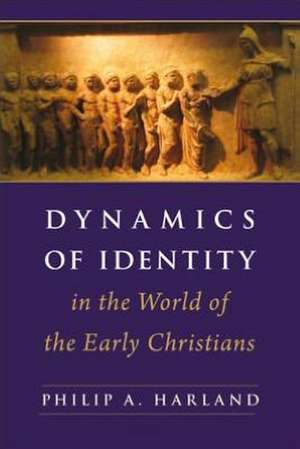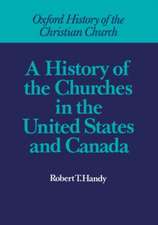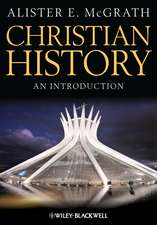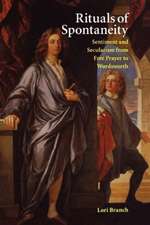Dynamics of Identity in the World of the Early Christians
Autor Assistant Professor Philip A. Harlanden Limba Engleză Hardback – 18 ian 2010
This study sheds new light on identity formation and maintenance in the world of the early Christians by drawing on neglected archaeological and epigraphic evidence concerning associations and immigrant groups and by incorporating insights from the social sciences. The study's unique contribution relates, in part, to its interdisciplinary character, standing at the intersection of Christian Origins, Jewish Studies, Classical Studies, and the Social Sciences. It also breaks new ground in its thoroughly comparative framework, giving the Greek and Roman evidence its due, not as mere background but as an integral factor in understanding dynamics of identity among early Christians. This makes the work particularly well suited as a text for courses that aim to understand early Christian groups and literature, including the New Testament, in relation to their Greek, Roman, and Judean contexts.
Inscriptions pertaining to associations provide a new angle of vision on the ways in which members in Christian congregations and Jewish synagogues experienced belonging and expressed their identities within the Greco-Roman world. The many other groups of immigrants throughout the cities of the empire provide a particularly appropriate framework for understanding both synagogues of Judeans and groups of Jesus-followers as minority cultural groups in these same contexts. Moreover, there were both shared means of expressing identity (including fictive familial metaphors) and peculiarities in the case of both Jews and Christians as minority cultural groups, who (like other "foreigners") were sometimes characterized as dangerous, alien "anti-associations". By paying close attention to dynamics of identity and belonging within associations and cultural minority groups, we can gain new insights into Pauline, Johannine, and other early Christian communities.
Inscriptions pertaining to associations provide a new angle of vision on the ways in which members in Christian congregations and Jewish synagogues experienced belonging and expressed their identities within the Greco-Roman world. The many other groups of immigrants throughout the cities of the empire provide a particularly appropriate framework for understanding both synagogues of Judeans and groups of Jesus-followers as minority cultural groups in these same contexts. Moreover, there were both shared means of expressing identity (including fictive familial metaphors) and peculiarities in the case of both Jews and Christians as minority cultural groups, who (like other "foreigners") were sometimes characterized as dangerous, alien "anti-associations". By paying close attention to dynamics of identity and belonging within associations and cultural minority groups, we can gain new insights into Pauline, Johannine, and other early Christian communities.
| Toate formatele și edițiile | Preț | Express |
|---|---|---|
| Paperback (1) | 258.42 lei 6-8 săpt. | |
| Bloomsbury Publishing – 18 ian 2010 | 258.42 lei 6-8 săpt. | |
| Hardback (1) | 832.26 lei 6-8 săpt. | |
| Bloomsbury Publishing – 18 ian 2010 | 832.26 lei 6-8 săpt. |
Preț: 832.26 lei
Preț vechi: 1066.61 lei
-22% Nou
Puncte Express: 1248
Preț estimativ în valută:
159.25€ • 166.72$ • 131.77£
159.25€ • 166.72$ • 131.77£
Carte tipărită la comandă
Livrare economică 05-19 aprilie
Preluare comenzi: 021 569.72.76
Specificații
ISBN-13: 9780567613288
ISBN-10: 0567613283
Pagini: 256
Ilustrații: 10
Dimensiuni: 156 x 234 x 23 mm
Greutate: 0.52 kg
Ediția:New.
Editura: Bloomsbury Publishing
Colecția T&T Clark
Locul publicării:New York, United States
ISBN-10: 0567613283
Pagini: 256
Ilustrații: 10
Dimensiuni: 156 x 234 x 23 mm
Greutate: 0.52 kg
Ediția:New.
Editura: Bloomsbury Publishing
Colecția T&T Clark
Locul publicării:New York, United States
Caracteristici
Inscriptions pertaining to associations provide a new angle of vision on the New Testament and on the ways in which members in Christian congregations and Jewish synagogues, as minority cultural groups, experienced belonging and expressed their identities within the Greco-Roman world.
Cuprins
Introduction
- Approaches to identity in the ancient Mediterranean world
- Social scientific perspectives
- Identity formation and maintenance among Jews and Christians
- Associations and identity
Part 1: Early Christian Identity and the Associations
1. Early Christian groups as associations in the Greco-Roman world
2. Christ-bearers and fellow-initiates: Local cultural life and Christian identity in Ignatius' letters
Part 2: Familial Dimensions of Group Identity
3. "Brothers" in congregations and associations
4. "Mothers" and "fathers" in associations and synagogues
Part 3: Acculturation and Identity among Judeans and Other Immigrants
5. Judeans among associations of immigrants and cultural minorities
6. Jewish families and "pagan" guilds at Hierapolis
Part 4: Encounters and Perceptions of the Other
7. Rivalries and the expression of identity: The case of associations at Sardis and Smyrna
8. Banquets of the anti-associations and perceptions of cultural minorities and Christians
Conclusion
Bibliography
- Approaches to identity in the ancient Mediterranean world
- Social scientific perspectives
- Identity formation and maintenance among Jews and Christians
- Associations and identity
Part 1: Early Christian Identity and the Associations
1. Early Christian groups as associations in the Greco-Roman world
2. Christ-bearers and fellow-initiates: Local cultural life and Christian identity in Ignatius' letters
Part 2: Familial Dimensions of Group Identity
3. "Brothers" in congregations and associations
4. "Mothers" and "fathers" in associations and synagogues
Part 3: Acculturation and Identity among Judeans and Other Immigrants
5. Judeans among associations of immigrants and cultural minorities
6. Jewish families and "pagan" guilds at Hierapolis
Part 4: Encounters and Perceptions of the Other
7. Rivalries and the expression of identity: The case of associations at Sardis and Smyrna
8. Banquets of the anti-associations and perceptions of cultural minorities and Christians
Conclusion
Bibliography
Recenzii
"Drawing from insights of the social sciences, Harland seeks to clarify certain dynamics of identity among groups of Judeans and Christians by looking at archaeological evidence for other contemporary associations and cultural minority groups. He covers Judean and Christians identities in the context of associations, familial dimensions of group identity, identity and acculturation among Judeans and other ethnic associations, and group interactions and rivalries. Specific topics include brothers in associations and congregations, Judean families and guilds at hierapolis, associations at Sardis and Smyrna, and anti-associations and their banquets." -Eithne O'Leyne, BOOK NEWS, Inc.
"Drawing on insights from the social sciences, Harland, associate professor of humanities and ancient history at York University in Toronto, and author of Associations, Synagogues, and Congregations: Claiming a Place in Ancient Mediterranean Society (2003), suggests that we can better understand certain dynamics of identity among groups of Judeans (Jews) and Christians by looking at archaeological evidence for other contemporary associations and other cultural minority groups. After a 21-page introduction, he discusses associations and group identity among Judeans and Christians; local cultural life and Christian identity--'Christbearers' and 'fellow-initiates'; 'brothers' in associations and congregations; 'mothers' and 'fathers' in associations and synagogues; other diasporas--immigrants, ethnic identities, and acculturation; interaction and integration--Judean families and guilds at Hierapolis; group rivalries and multiple identities--associations at Sardis and Smyrna; and perceptions of cultural minorities--anti-associations and their banquets. Harland concludes that among the distinctive characteristics of Christians and Judeans that stood out to many insiders and outsiders was their attention to one, Judean God to the exclusion of other deities; and that this distinction was a potential source of tensions with many other groups and individuals within their contexts, and could lead to social harassment and persecution on particular occasions." -New Testament Abstracts, Vol. 54
Until recently, scholars of early Judaism and Christianity have generally pursued the differential quality. Harland's effort to broaden that perspective by seeing what we might learn about Judeans and Christians by considering their similarities to other "cultural minority groups" in antiquity, even if it is overstated at times, therefore comes as a welcome alternative. The sharpness with which Harland presents that perspective makes it all the more rewarding.
Harland has provided a rich and broad-ranging inquiry that deserves a place in any mature library.
In total, Harland helps us see the emergence of early Christianity with clearer lenses. . . . Harland has provided us with a text from which the seasoned scholar or the intermediate student might engage in a fresh approach to the important ancient textual and archeological material.
"Drawing on insights from the social sciences, Harland, associate professor of humanities and ancient history at York University in Toronto, and author of Associations, Synagogues, and Congregations: Claiming a Place in Ancient Mediterranean Society (2003), suggests that we can better understand certain dynamics of identity among groups of Judeans (Jews) and Christians by looking at archaeological evidence for other contemporary associations and other cultural minority groups. After a 21-page introduction, he discusses associations and group identity among Judeans and Christians; local cultural life and Christian identity--'Christbearers' and 'fellow-initiates'; 'brothers' in associations and congregations; 'mothers' and 'fathers' in associations and synagogues; other diasporas--immigrants, ethnic identities, and acculturation; interaction and integration--Judean families and guilds at Hierapolis; group rivalries and multiple identities--associations at Sardis and Smyrna; and perceptions of cultural minorities--anti-associations and their banquets. Harland concludes that among the distinctive characteristics of Christians and Judeans that stood out to many insiders and outsiders was their attention to one, Judean God to the exclusion of other deities; and that this distinction was a potential source of tensions with many other groups and individuals within their contexts, and could lead to social harassment and persecution on particular occasions." -New Testament Abstracts, Vol. 54
Until recently, scholars of early Judaism and Christianity have generally pursued the differential quality. Harland's effort to broaden that perspective by seeing what we might learn about Judeans and Christians by considering their similarities to other "cultural minority groups" in antiquity, even if it is overstated at times, therefore comes as a welcome alternative. The sharpness with which Harland presents that perspective makes it all the more rewarding.
Harland has provided a rich and broad-ranging inquiry that deserves a place in any mature library.
In total, Harland helps us see the emergence of early Christianity with clearer lenses. . . . Harland has provided us with a text from which the seasoned scholar or the intermediate student might engage in a fresh approach to the important ancient textual and archeological material.














